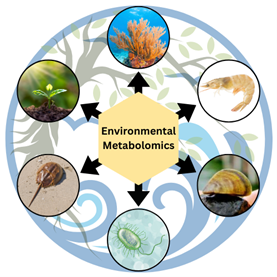Summary
The metabolomics program at NIST is a collaboration between multiple institutions located at the Hollings Marine Laboratory (HML) in Charleston, SC. This research effort involves the study of aquatic organisms, including microbes and marine mammals, and is supported by state-of-the-art analytical facilities that include a high-field nuclear magnetic (NMR) facility and a high-resolution mass spectrometry (HRMS) laboratory.
By applying NMR, an unbiased discovery tool, and MS, a more sensitive tool, to investigate non-model organisms, the program aims to bring new understanding to their biochemistry. Additionally, it seeks to answer questions on the global impact of environmental contaminants and other stressors, ranging from physical changes in the environment to industrial and urban pollution.
Description

The application of metabolomics techniques to environmental systems biology offers a promising opportunity to achieve insights into non-model organism biology. Each biological system manifests distinctive challenges that offer insights into criteria important for rigorous study design and method development. Research in environmental metabolomics will yield the introduction of new techniques, protocols, and data tools for application to diverse measurement challenges.
current projects
- Biomonitoring and Ecotoxicology: Mussels have been widely used in both marine and aquatic environments to monitor impacted environments and areas of concern by measuring contaminant levels in in their tissue. The plethora of new and emerging chemicals of concern in the environment is outpacing agencies' resources to monitor chemical contaminants and assess their toxic effects. A reverse approach to monitoring has been recommended where molecular level biological effects are assessed first. The biomolecular response of the organism will reflect the sum of stress initiators. NIST is collaborating with the National Oceanica and Atmospheric Agency’s (NOAA) Mussel Watch Program and the Great Lakes Environmental Research Laboratory to investigate metabolic changes that occur in Dreissenid mussels due to their biology, reproduction, natural environmental variations, and chemical contaminants. The aim is to develop a bio-measurement strategy at the ecosystem level using these invasive mussels.
- Biomedical Applications from Natural Products: Horseshoe crabs are vitally important organisms in the biomedical industry, due to the presence of amoebocytes in their hemolymph (blood), which can isolate bacterial endotoxins by quickly clotting around them. For this purpose, amoebocytes are extracted from horseshoe crab hemolymph to produce Limulus Amoebocyte Lysate (LAL), which is used to test for the presence of toxins in injectables and medical devices destined for the human body. LAL is also critical in the mass production of vaccines and has been essential in the development of vaccines for the SARS-Cov-2 virus (COVID-19). NIST is collaborating with the South Carolina Department of Natural Resources (SCDNR) and the College of Charleston to investigate the physiological effects of age and temperature on blood chemistry, metabolism, and mortality of harvested American horseshoe crabs (Limulus polyphemus), with particular focus on NMR-based metabolomics analysis of horseshoe crab hemolymph.
- Climate Change and Anthropogenic Impacts: The use of molecular -omics techniques to study coral health will improve understanding of coral reef ecosystems in the face of climate change and anthropogenic disruption. We endeavor to develop robust field-sampling methods and optimize omics workflows for coral samples, to improve the quality of coral omics data worldwide for analysis of reef-building corals. Application of our workflows are being used 1) to begin to understand the molecular pathology of coral growth anomalies often prevalent in populated regions, 2) to characterize the metabolome of important reef building species exposed to conditions that naturally simulate the potential sea surface temperature rise and the intensification of ocean acidification, and 3) to evaluate the coral-algae-microbiome synergy in temperature corals that thrive with and without facultative algal symbionts. The baseline biochemical information may lead to an understanding of the mechanisms by which corals survive and fulfill their functional roles in ecosystems, even under extreme conditions.

